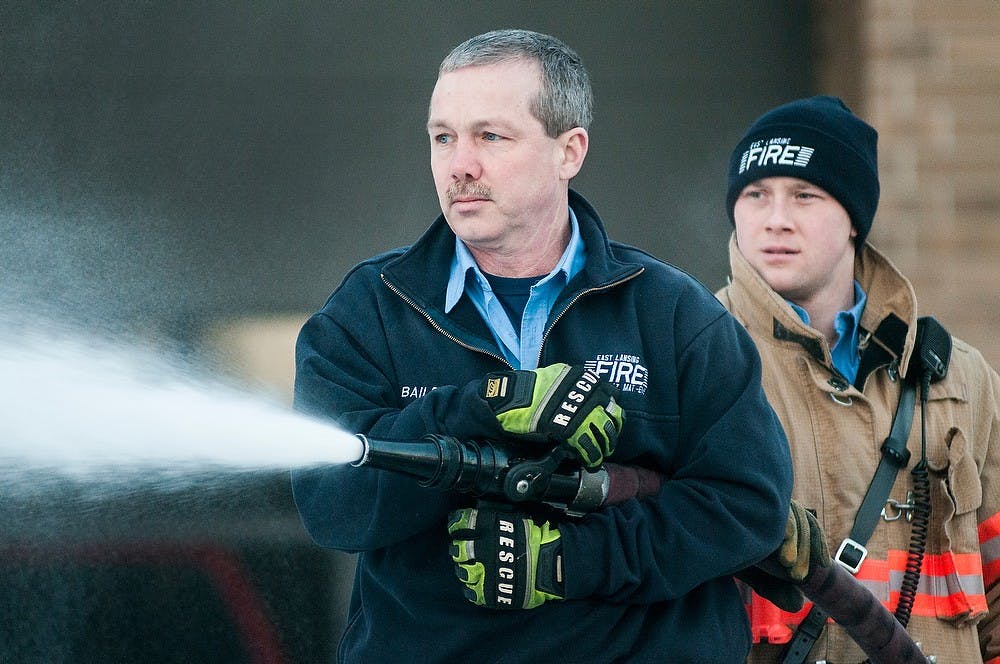East Lansing and Lansing Fire Department Fire Chief Randy Talifarro works between 40 and 50 hours a week, receives 100 or more emails a day and treks between East Lansing and Lansing daily.
Adding time spent outside of work at city council meetings and other community events, his work week sometimes can stretch to nearly 70 hours.
That’s because Talifarro is one man working a job made for two.
One year ago, Talifarro began serving as the fire chief for both the East Lansing Fire Department, or ELFD, and Lansing fire department, when the two cities agreed to share his services after former Lansing Fire Chief Tom Cochran retired.
The deal, which took effect Jan. 15, 2012, expired Monday.
East Lansing City Council will decide whether to approve a new year-long agreement for Talifarro to remain fire chief for the two departments at today’s regular meeting at 7:30 p.m. in City Hall, 410 Abbot Rd.
If the agreement is approved, Talifarro will continue to do what he started a year ago: bring more collaboration between the fire departments in the Lansing area communities.
Facing another year
East Lansing City Manager George Lahanas plans to recommend council approve the new year-long agreement.
“The city of Lansing is interested in extending it as well,” he said. “At this point we’ll look to extend it from this Jan. 15 until next January.”
Not much has changed in the proposed agreement, other than new language requiring the city of Lansing to pay about 50 percent of Talifarro’s $119,000 salary. Originally, Lansing was required to pay between 40 to 60 percent of his salary depending on where he spent most of his time.
Lansing also must pay a 2 percent late charge if payment is not received 30 days from the invoice date.
By having Talifarro spend part of his time in both Lansing and East Lansing, Lahanas said the city is giving up something by not having him spend all his time at the department.
“He’s not needed on a day-to-day basis to fight a fire,” he said “It doesn’t lessen our fire emergency response right now. But what it does stop is that perhaps it’s less time for him to tackle the issues he wants to tackle.”
Gerald Rodabaugh, ELFD fire marshal and president of the local 1609 Firefighters Union, said when handling two departments, some things are going to be put on the back burner. It might be as small as not having the time to talk to staff or other personnel, but it’s still something Rodabaugh will miss.
“Is it a negative issue? Some days yes, some days no,” he said. “Is it the end of the world? No.”
Talifarro said getting everything done is any fire chief’s challenge.
It’s probably the same for most administrators with a lot of responsibilities, but it helps having colleagues to delegate to, Talifarro said.
“You have to have other staff who’s doing their part,” he said. “Have people contributing at all levels, not just one person.”
Shared resources
Talifarro’s added responsibilities as Lansing fire chief coincided with a study on shared services between the fire departments in East Lansing, Lansing, Delhi Township, Delta Township, Lansing Township and Meridian Township. Consulting firm Plante Moran conducted the study.
Support student media!
Please consider donating to The State News and help fund the future of journalism.
The study, released in June 2012, explored how the six departments can better collaborate, although Talifarro said collaborations between the departments was happening long before the study was finished.
The departments have a joint hazardous material response team and joint urban search and rescue team that serve Greater Lansing. The departments also purchase shared equipment.
Lansing, East Lansing, Meridian Township and Delta Township train together to help teams work together and better prepare for mutual aid responses.
For big events in East Lansing, such as home MSU football games or concerts, the ELFD brings in help from the Meridian Township Fire Department and Lansing Fire Department.
The big plan
The fire study described a four-phased approach on how the departments could better collaborate during a six or seven year process.
One of the approaches in the first phase is automatic mutual aid, where the closest fire department to an emergency would respond, regardless of jurisdictional lines.
“It’s a very good concept,” Rodabaugh said. “But it has to be thought out.”
Rodabaugh said the departments started talking about having the same policies and procedures in place to respond to emergencies, but it might be a while before that’s accomplished.
Rodabaugh said it must be well planned so departments can deal with complex situations, such as making sure all trucks are properly staffed — no matter who responds to a fire.
The cooperation between both departments has allowed East Lansing and Lansing to receive more than $2 million in staffing grants from Federal Emergency Management Agency, as the grants were weighted to include regional cooperation.
Talifarro said grants helped maintain the staffing levels in East Lansing and helped pay for 12 laid-off Lansing firefighters to rejoin the force.
The last phases of the collaboration approach recommended cutting firefighters from full-time to part-time and merging departments to save money.
Councilmember Kevin Beard said none of the departments have agreed to a merger or to a full consolidation of the departments.
“I will resist any attempt to cut our professional firefighters back to part-time,” Beard said.
Although the study gave useful suggestions to help save money and resources for both departments, it’s doubtful whether all recommendations will be followed in the long run.
“It was only designed to examine the merit of further discussion about consolidation,” Talifarro said.
Discussion
Share and discuss “Working Together: One Year Later” on social media.




